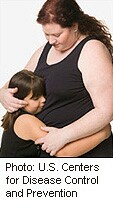
MONDAY, April 16 (HealthDay News) — Little girls from troubled homes are more likely to be obese at age 5 than girls from happier ones, new research shows.
However, researchers did not find that same association between boys’ weight and difficult family situations.
In the study, researchers looked at data on more than 1,600 preschoolers from the Fragile Families and Child Wellbeing Study, which tracks the health and well-being of children born to mostly low-income, single-mother families. About half were black, 27 percent were Hispanic and 22 percent were white.
When their children were aged 1 and 3 years, mothers were asked about six stressors: domestic violence, depression, drug abuse, housing insecurity, food insecurity (meaning that their household didn’t always have enough nutritious food to eat) and whether the child’s father was in prison. Children’s height and weight were measured at age 5.
At 5 years old, 17 percent of the children were obese, defined as having a body-mass index in the 95th percentile or above, or being heavier than 95 percent of their peers for their height.
Girls whose mothers reported experiencing two or more stressors when their daughter was age 1 were twice as likely to be obese at age 5. If the mother reported experiencing two or more stressors when the daughter was age 3, the girl was also about twice as likely to be obese.
Researchers found a trend toward a similarly high risk of obesity if the mothers reported experiencing stressors when their daughter was aged 1 and 3, however the results were not statistically significant. Researchers believe that doesn’t mean there isn’t a link, just that this sample wasn’t big enough to show it.
The results suggest that pediatricians and others trying to stem the childhood obesity epidemic need to consider the family dynamics and home environment, rather than just the girl’s weight.
“For families who are experiencing all these stresses, obesity is one more thing and may not be as high a priority as other things,” said study author Shakira Suglia, an assistant professor in the department of epidemiology at Columbia University, in New York City. “Particularly for girls, when you’re seeing these patients coming in as obese children at age 5, there is probably more going on than what they’re eating and what their physical activity is. … There are other things going on in the family environment that need to be addressed to improve the health of the child.”
The study is published in the May issue of Pediatrics.
There are several explanations thought to be behind the stress-obesity connection, said Christina Bethell, a professor in the pediatrics department at Oregon Health & Science University and director of the Child and Adolescent Health Measurement Initiative.
“The connection between stress, health behaviors and obesity is profound and many say that to deal with obesity, first we have to deal with psychosocial issues and stress,” said Bethell.
There may be a direct relationship, in that kids who are stressed because of difficult home life may be more prone to eat highly caloric foods. Studies have suggested in adults that stress prompts people to reach for “comfort foods,” Suglia said.
But there may be indirect effects as well. Mothers who are stressed, or who are dealing with worries such as violence or serious economic instability, may not be as emotionally available to their kids, Suglia said, and may put kids in front of the TV or feed them junk food to keep them occupied as they try to deal with their own problems.
Economic instability may mean families can’t afford or believe they can’t afford to buy fresh produce, lean cuts of meat and other nutritious foods, she added.
Prior research has found stress caused by domestic violence and poverty is associated with greater risks of cardiovascular disease in adults.
An open question, however, is why there wasn’t an association with obesity and troubled homes in boys. There are several possible explanations, Suglia said.
“It’s possible that girls internalize things differently. Other studies have shown they do act differently in being exposed to stress. Girls tend to internalize more, and to have more depressive behaviors,” Suglia said.
Boys are generally more physically active than girls even at a young age, so all of their running and jumping may help ward off obesity longer. Boys and girls also develop differently, so it’s possible that girls are picking up more on maternal worries while boys are paying less attention, making them less vulnerable to it, Suglia said.
“In the domestic violence literature, we’ve found that girls identify more with the mom more than the boys,” Suglia said.
But none of these are proven explanations. Indeed, researchers found that girls who grew up with these psychosocial risk factors were more likely to be obese than kids from more peaceful homes, but not that a difficult home life caused the obesity.
More information
The Annie E. Casey Foundation has more on kids and well-being.

